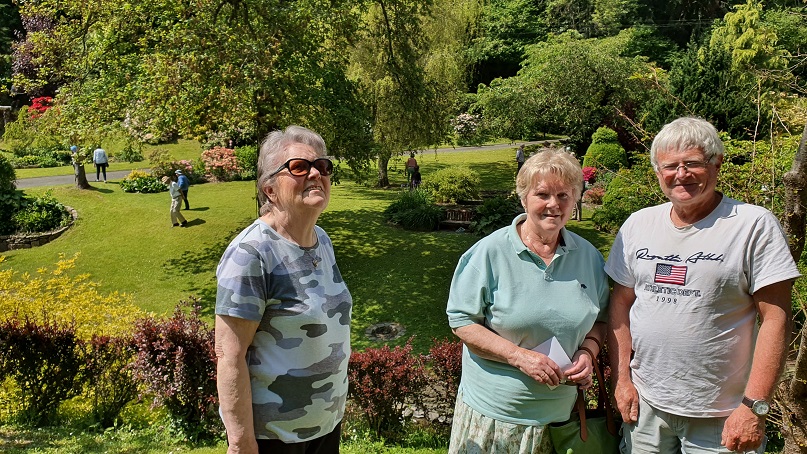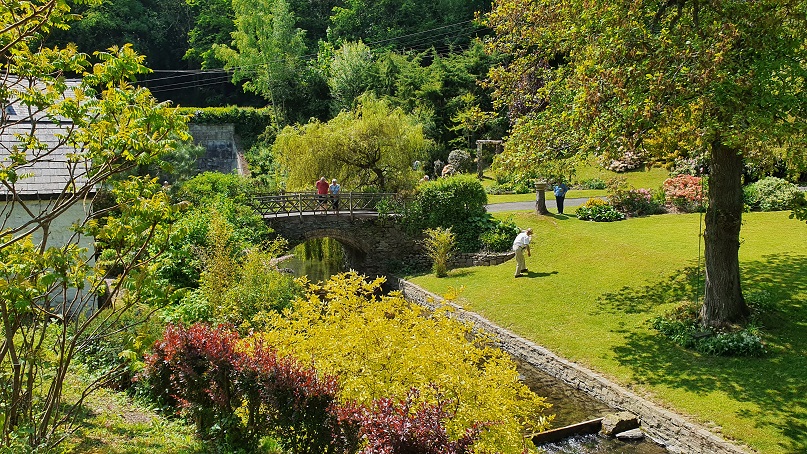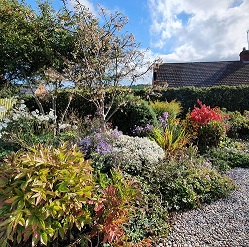|
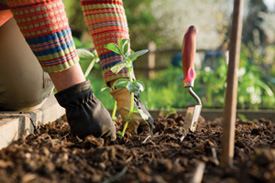 |
| | Home
| Literary Group
| Film Appreciation
| Gardening
| Technology
| Walking | Luncheon
Club | MahJong
| Environment | Rummikub | Classical Music | Members of U3A are all welcome to join the activities of the groups. Contact details of leaders are given in the Programme of Events. |
|
|
This Gardening Group was started in May 2009 with the intention of visiting members and public gardens and discussing relevant topics. Typical topics discussed are pros and cons of organic gardening, pest and weed control techniques, climate change, gardening for the credit crunch, etc. Other discussion topics will be wine making, and techniques, such as bottling, freezing, etc that are successful for dealing with excess produce. At each meeting members describe their current activities in the garden and discuss plants being grown, pests encountered, techniques and supplies used, and their successes and failures. Members also share seeds, cuttings and coordinate the purchase of seeds and plants. November. This month we met at the home of Lynn who took us through a
list of what we should be doing in our gardens at this wintery time of year -
not very much we were all pleased to learn unless we were going to revamp our
gardens in any way or increase our trees and shrubs as now is the ideal time to
plant or divide. We reported on how our gardens have survived during
this very strange, particularly hot year - some successes, some failures. After coffee and cake we walked around Lynn's garden,
strawberry plants in abundance - 3 beds. Her raspberries - both
summer and autumn having done well and now in need of cutting right down.
Her hydrangeas are looking very healthy - and will do until the first frosts,
best to leave them unpruned as the growth will protect the plant throughout the
winter. One more meeting at Paul's home in December and then we pack up our spades until Spring, around March time, when we should be planning our plots for a new season. October. The meeting this month was at my home in Tregynon. As
usual, we discussed the successes and failures of plants in our own gardens -
everyone agreeing that it had been a very good year for tomatoes. For the first time , Paul had tried growing a butternut
squash in his greenhouse. He had no squashes but the plant grew like a
triffid and wound its way around the greenhouse. He is going to try again
next year, he feels that the leaves of his plant prevented his tomatoes from
suffering from heat stroke on the very hot days this summer. As usual,
his vegetables in the garden were a great success. Nick reported
some of his veg. did well and some failed dismally. Lynn, Nick and Paul
said that their raspberries produced a bumper crop. Paul has decided to
do away with his old strawberry plants and has been growing new plants from the
runners. We all agreed that we preferred raspberries to strawberries! I
commented that all the s/berries I bought from the supermarket, were not
completely ripe and the centre was white and hard, maybe they were picked too
soon. We discussed the problems that the very hot weather presents
- runner beans hate the heat - mine were very poor, but the climbing french
beans loved the heat and I had a bumper crop - pity, as I prefer runner beans. We had a list of jobs to do this month, some we had already
carried out - such as planting garlic - while others would be attended to over
the next weeks. One we should be attending to fairly soon , is clearing
out the pond - only Nick and I have ponds. Mine is very healthy and clear
but is being taken over by water hawthorn. This plant is very pretty with
lots of white flowers and largish oval leaves, but it is a bit of a thug.
Throughout the year it detaches baby plants and they float on the surface and
then attach themself to the sides of the pond or other plants and soon you have
too much of a good thing! I must thin them out. My pond had lots of
tadpoles and newts this year, I don't often see newts in the pond but find them
whilst weeding the garden. We stopped for coffee and cake and then walked around
the garden. My garden is rushing through autumn, some shrubs have turned
beautiful colours, my Cercidiphyllum Japonicum or Katsura Tree is related
to the common spindle. Sometimes it gives off a scent like burnt
sugar. The leaves are heart shaped and now bright yellow. I have
about 8 Euonymus shrubs - also known as the spindle tree. There are
many different species ranging from those with small green and cream leaves to
those I have, their leaves turn bright red in the autumn and hold onto them for
about 3 months. The seeds of some are also interesting they hang down
from the plant with little red hats and the seeds are bright orange and hang on
strands - the birds love them. My crab apple tree is glorious - it is
smothered in small yellow fruits. Last year a late severe frost turned
all the fruits to blobs of brown so the birds had none as the frost came before
the fruits were ripe. Let's hope it's not repeated this year.
Because of the relatively mild weather lately, some annual flowers are hanging
on - I have two pots of small begonias, one a bright orange colour called
glowing embers and the other hanging in a wall pot , a bronze red called
starshine and still covered in flowers. Next month the meeting will at Lynn's home in Newtown. September. This month we met at Garthmyl Hall a Grade 1 listed house
nr. Berriew. The first building on the site was a large
timber-framed mansion of late 17th c. This was replaced in 1762 and then
again rebuilt as a private residence in 1859 by the architect James
K.Colling for Major General William George Gold. It has now been
transformed into an exclusive wedding venue by the present owners. It has formal and informal gardens with a lake and trees set
in a small park, including a huge mature Cedar of Lebanon. There is a
large walled garden with fruit trees, hostas and many beautiful
roses. The centre of the garden has flower beds which form a huge
circle. These are planted with colourful perennials and annuals which are
repeated often so the beds join seamlessly together. In one
of the small fields there are 2 sections devoted to meadow planting
containing wild flowers such as cranesbill, field poppies and grasses
with the addition of field poppies, cornflowers and colourful cosmos.
Mown pathways lead through the plantings. It was a gloriously hot, sunny day when we visited and after walking around the garden , tea and cake in the marquee was very welcome . July. On Sunday the Garden Group visited Cwm Weeg, Dolfor
-the C15th medieval farmhouse owned by Wolfgang Schaefer and
Kingsley George. After nearly 3 decades of living at the Cwm, major
landscaping and gardening projects were undertaken and there has hardly been a
period without ongoing building work, the latest being the Pavilion built in
2019 - an ideal spot overlooking the garden , perfect for coffee
and cake and musical evenings. The various projects include
terraces, fountain, 4 ponds, grotto, moss garden with rock face and
Stumpery. There are statues and sculptures throughout the 2.5 acre
garden, set within 24 acres of wild flower meadows and bluebell woods. The garden planting is astounding and on such a large
scale it made us tired just looking at it, thinking of all the effort which
must go into keeping this beautiful garden in tip top condition. If you haven't yet discovered this wonderful garden, put it
on your 'must see' list. We visited Paul's garden once again this month. His vegetables
have come on a pace since we last saw them and a lot of his herbaceous plants
are flowering. The problem here is that his island bed is quite stuffed
with them and some are hidden from view. He is going to sort out this
problem by removing some plants and pruning others so there is more light
getting into the middle of the bed - his hydrangeas may then flower - at the
moment they are sulking in the gloom.However, the cornflowers are very much at
home and are flowering very well. It's lovely to see a sea of
various shades of blue as it's not a colour you find often in many
gardens - the exception being ceanothus, Himalayan poppy and spring bulbs
such as scilla and anemone blanda. He has a wonderful row of peas, his onions look very strong,
his spinach, broccoli, beetroot and sweet corn are doing fine and his potatoes
are tall and still growing! His greenhouse is full of tomatoes, cucumbers
peppers and this year he is trying butternut squash. He has some outdoor
tomatoes too and they are thriving. His soft fruit - blackcurrants and
raspberries are growing well too. In fact , his whole vegetable
plot is a good example of what can be achieved using home made compost
and devotion of time. 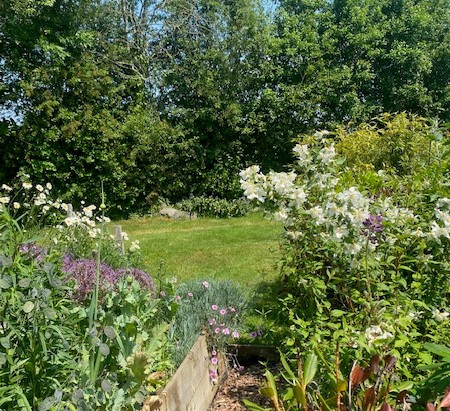 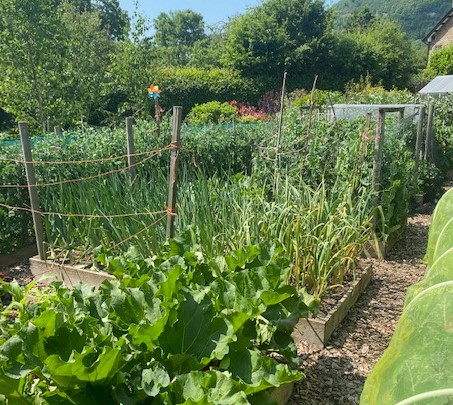 On May 211st the group visited the NGS garden at Rock Mill, Abermule on a glorious sunny day..
This month's meeting was held at Lynn's, Canal Road,
Newtown. We started off with Lynn giving us a list of jobs we should be
doing in the garden this month. She obtained this list from Gardeners'
World which sometimes is in advance of our Welsh gardens but this time was
quite accurate. We were told we should still be careful planting out any
tender annuals/bedding/hanging baskets as we could still have late frosts to
decimate them. We discussed the earlier frosts, some before Christmas and
the others just a short while ago which killed some plants in all our gardens. Paul is a very keen vegetable grower and he told us about
how all his young plants are progressing. His potatoes are 2 feet tall
and very healthy, he is worried that they won't survive a frost, he had one
last year which killed all the new foliage but the potatoes sprouted again and
grew into sturdy plants, the plants were very short on that occasion though.
His broad beans are thriving as are his brassicas. He gave Anne 2 Kale
plants to try as they were a new variety to him and supposedly even good to eat
raw. Both Lynn and Anne were promised some of his spare tomato plants to
try growing outside - they are hoping for weather similar to last year - lovely
and warm for the fruit to ripen. The problem though with the
very warm weather is that vegetables such as runner beans do not do well in the
heat and give only a light crop. Anne has decided to grow fewer runner
beans this year but also to grow French climbing beans which cope better with
the heat. Then we stopped for a tea/coffee/cake break followed by a tour of Lynn's garden. She has quite a number of shrubs including Philadelphus with hostas, hydrangeas and many clematis. Lynn has a large number of strawberry beds, summer and autumn raspberries, rhubarb and then l plant of each of blackcurrants, gooseberries and a blueberry. She also grows runner and broad beans, but has nipped out the shoots of the latter to avoid blackfly - she was misinformed but hopefully the plants will survive and bush out, they look healthy enough to do so. We met at Anne's house in Tregynon this month on a damp
drizzly day. We managed a quick gallop around the garden, lots of spring
bulbs such as scilla,primroses, anemone blanda, daffodils and many
hellabores which have spread like wildfire throughout. There are also 10
or more pots of tulips and daffodils at the front of the property making a very
colourful display. A few of Anne's trees and shrubs have died over the winter -
she puts this down to the severe heat of summer and the hard frosts before and
after Christmas. She is hopeful that a few may recover after all the
recent rain, one can only hope! Anne has many bluebells scattered about the garden, some the
wild variety and some Spanish plants. She is not fussy about them cross
pollinating and lets them live happily side by side. We discussed a list of jobs we should be doing outside this
month and talked about plans for our individual gardens. Paul is
well on with his sowing regime and is keeping his fingers crossed for an
absence of frost as his broad beans and potatoes in particular are galloping
on. Throughout her time in Tregynon, Anne's garden has been
visited by hedgehogs, they hibernated for most of the winter but are now eating
2 bowls of food which she puts out nightly. She has 2 feeding stations
which have been built to exclude cats and 2 houses where they can overnight
or hibernate in. The pond is full of tadpoles, after laying the
spawn at the shallow end of the pond, it snowed and froze, but enough of the
eggs survived and the frogs hadn't finished spawning by that time so more was
produced. We then enjoyed cups of tea and coffee and a chocolate
easter cake decorated with easter eggs! The May meeting will be on the 2nd Monday of the month at
Lyn's home in Newtown. After a few months off over winter, the Garden Group met at
Paul's house in Llanwnog. We chatted about many things, the no-dig method
which has recently become very popular - the reasoning behind this being
that the less the soil is disturbed the better for plants and the little
creatures such as worms, which live in the soil. We discussed bug infestations
and the best way of dealing with these - most gardeners try to be organic
and the way forward here is using a spray of soapy water to blast the aphids
etc. off the plants. Ideally ladybirds would keep such pests in check, but
unless there are very many of these insects in gardens, then the pests win
hands down.We also talked about the pruning of trees , shrubs and fruit bushes After drinks and cake we ventured into Paul's garden in
pouring rain. He has started off many flowers and vegetables, some on
indoor windowsills and others in his greenhouse. His broad beans looked
especially healthy and were ready to plant out - when the deluge stopped. Paul grows a great variety of veg which crop well each
year. He uses his own compost which he makes in large bays in the corner
of his plot. Our November meeting was a 'bring and share' lunch at Judi's
home. She read out a list of jobs we should be doing in the garden
- really just a continuation of October's jobs - cutting down collapsed
perennials - and division of same. Also planting new trees and
shrubs. Generally getting the garden tidy for the winter months.
Because of last week's frost, most trees and shrubs dropped what remaining
leaves they had and it's now a tidying up period - only removing them from
lawns - the worms will eventually break them up on the borders and you have
free compost! It was rather a sad meeting as we all said goodbye to Judi,
she has been a very active and enthusiastic member of our U3A from the
moment she joined. We wish her well in her new home.
I understand there is a U3A a short distance from her house and I'm sure they
will soon benefit from her willingness and enthusiasm. The October meeting was held at Nick's home in Abermule. We
walked around Nick's garden. He has a patch of lawn dotted with a mystery
fungus but the surrounding lawn looks very healthy. Nick will investigate
further. He has a large dome covered with a very fine gauge
netting. This has been successful in keeping out the dreaded cabbage
white butterfly resulting in a good crop of healthy looking sprout plants
and kale. However, his nearby leeks and celery plants are at a
standstill, they look healthy but are not growing. Paul suggested that
perhaps they were not getting enough sun as the area is shaded by the
house. The group discussed jobs we should be doing in our garden at this
time of year and we disagreed over a few as the weather is still so mild that
some garden plants are not not yet ready to shut down for winter. There should
be colour in the garden even now, some plants have beautiful autumn colour -
reds, oranges and yellows and dahlias will last until the first frosts while
Chrysanthemums and michaelmas daisies can survive low temperatures and be with
you into December. This time of year is usually a very busy time for the
gardener - now is the time to plant new trees and shrubs and divide
perennials. Annuals can be disposed of and herbaceous plants
divided. However, grasses should not be divided until the spring as they
can sulk and rot off over winter. Some plants have attractive seed heads and
these can be left to provide food for birds and cover for insects over
the winter and cut down in the spring - of course this depends on whether
they have collapsed into an untidy mess or not. Vegetable growers may still be harvesting beetroot and even
tomatoes in some areas, whereas broccoli, cabbages, carrots, parsnips and
leeks will last well into the winter months. Garlic can be planted now
and broad beans for an earlier crop next year, although the main opinion
regarding the beans is that over winter they have difficulty surviving
attack by mice and slugs and if sown in spring generally catch up. The next meeting will be the last at Judi's as she hopes to
move house at the end of November. 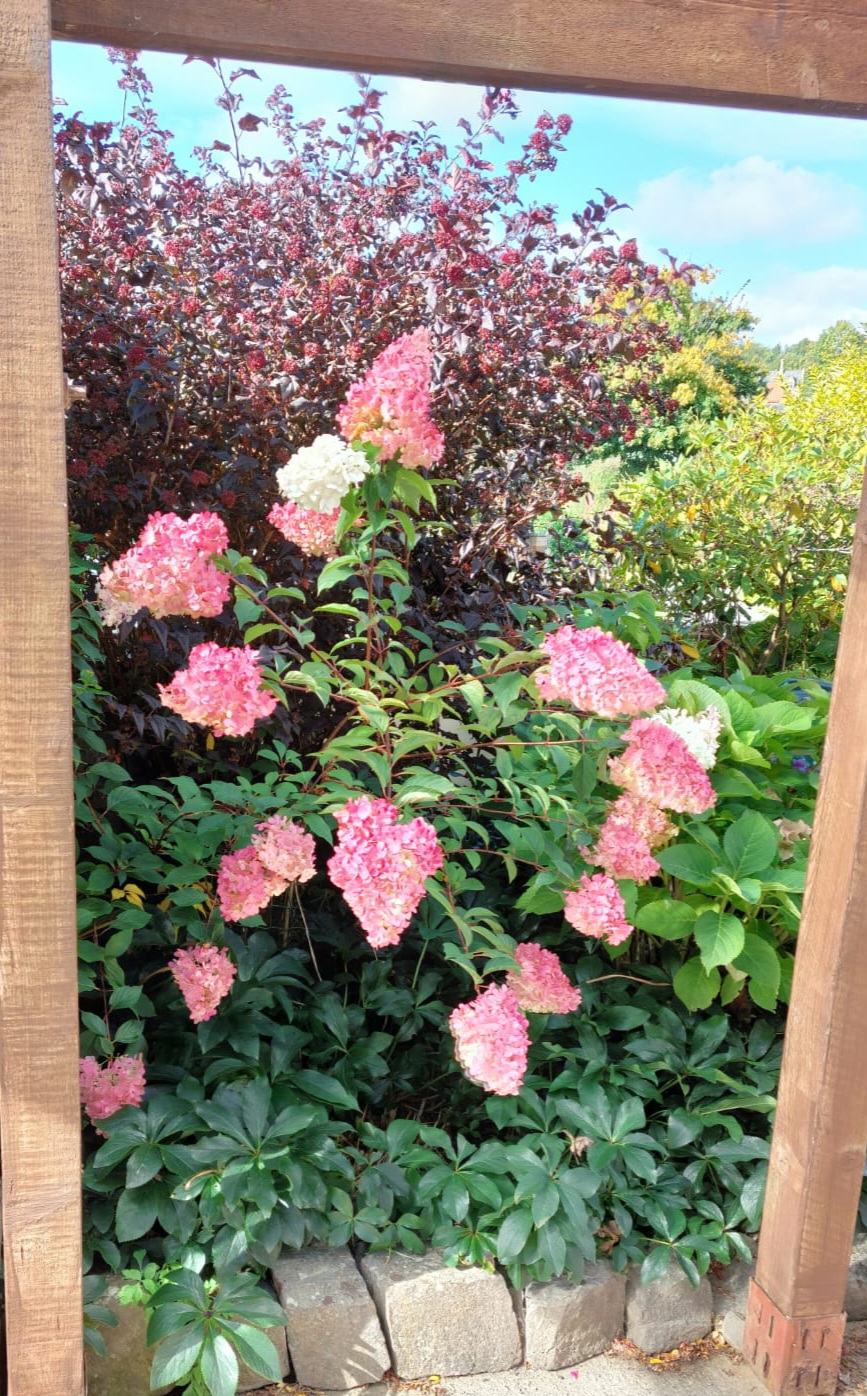 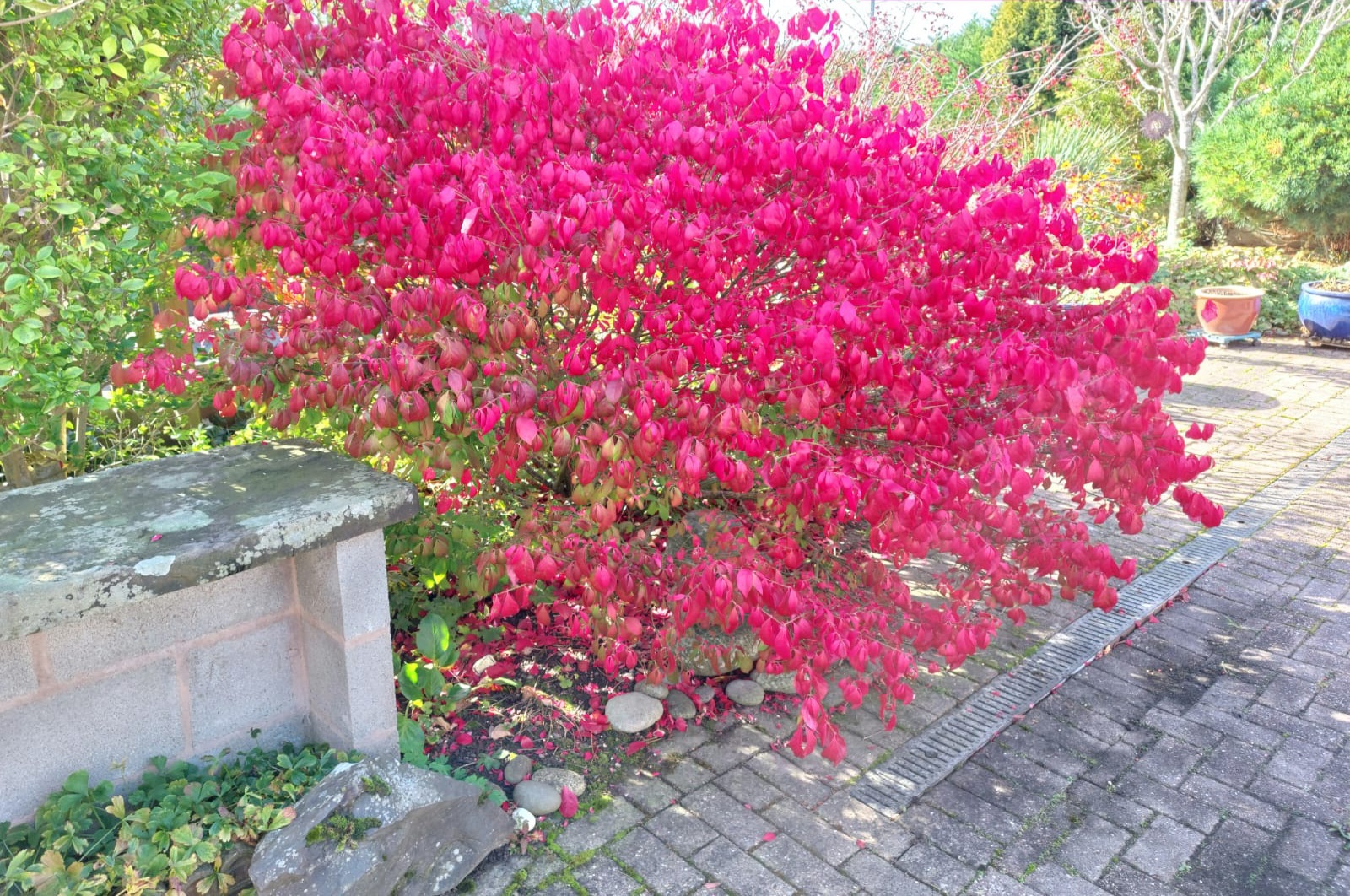 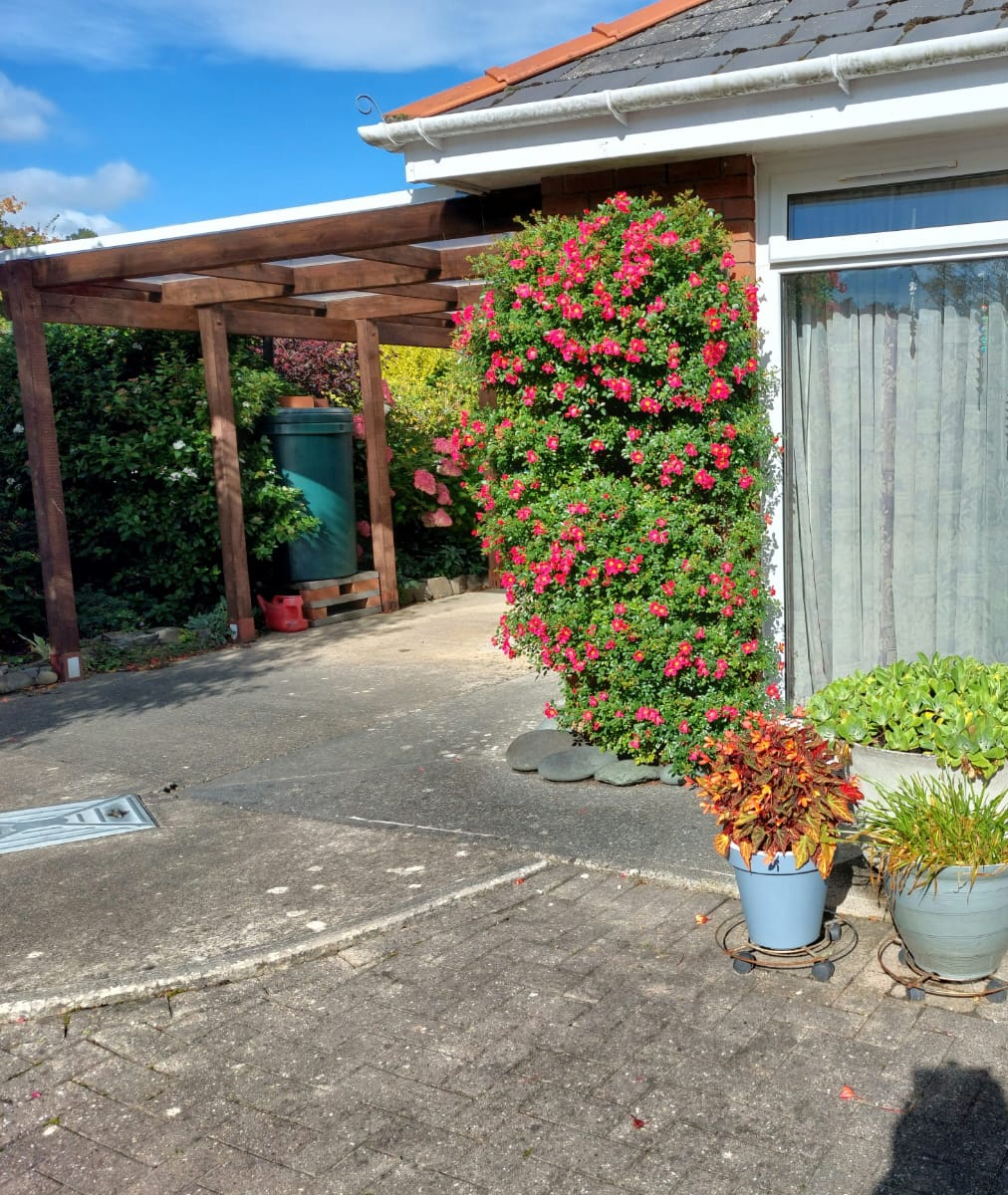
______________________________________________________________________________________________________ In September the group met at the home of Lynn Arthur - Cae
Camlas, Lower Canal Road, Newtown. Lynn's garden encircles the
house. She has mainly raised beds containing shrubs and vegetables - a
lovely crop of autumn raspberries still producing a lot of fruit. Her runner beans are
also still producing although I suspect this late in the year, the remainder of
the crop which looked mature will only be good for keeping for next
year's seed Her bed of hydrangeas which have been pruned quite severely,
are now recovering nicely and will make a good show next year. Because of the raised beds, the garden is very manageable
for Lynn and her gardener who helps when needed.. 9th May was the date of the monthly meeting of this
group. It was held at Anne's in Tregynon with only 4 persons attending -
Jackie being in hospital awaiting an operation and Judi on holiday. Irene has
now left the group, because of her move back to Shropshire. Anne gave a short talk on the pruning of fruit trees and
shrubs and also read out a list of jobs to do in the garden this
month. As with all our meetings, the conversations were varied and lively
- discussions on types of vegetables grown by members, composting and successes
and failures in the flower garden. After tea and cake the group toured Anne's garden - lots of
colour from azaleas,rhodos, bluebells, cammasias and other herbacous plants. The June meeting (organised by Judi) will be replaced by a
visit at 10.30 on 20th to Little House, Llandinam - a little gem of a garden
set out by a true plantswoman. This visit was advertised at the last
general meeting of the U3A. It will be announced again in June and
opened to members. The April meeting was on the 4th at the home
of Paul West. Attending: Anne Allen Lynn Arthur Judi
Deakin Nick Platt Anna Pugh Paul West The meeting began with a discussion about a group
leader. As no-one volunteered Anne suggested that we meet at a different
member's home each month and that member take the meeting. This was
carried. It was decided that we continue to meet on the 2nd Monday of
each month, and for 3 summer months, to replace the meetings with visits
to local gardens. Judi volunteered to arrange these visits. Car
sharing would take place.If the various garden owners required a minimum
number then the visits would be open to other members of Newtown U3A. An
appeal for more members would be made at the next general meeting. Paul read out a list of jobs to do in the garden this
month such as putting in early potatoes, sowing annuals, dividing
perennials etc. weeding and mulching borders. We chatted about our own gardens and how advanced or behind
we were - the difficult weather - hot by day, freezing by night -
making it a full-time job caring for our seedlings We had a tea and cake break and then were shown around
Paul's garden. He moved to his present address about 2 1/2 years
ago. He inherited a greenhouse, many water butts, raised beds of
shrubs and herbaceous plants and a large vegetable plot containing raised beds
and a rabbit proof fence. Paul's main interest is growing vegetables and this was very
obvious from the quantity and variety he has in the garden already.
He is a great believer in reusing as much as possible - all spent compost is
sieved and added to leafmold or his own garden compost (he has 2 large
bays in the corner of his plot where he composts all his household waste,
together with cardboard and any odd scraps of paper and packaging).
He even uses the wood chips from old garden paths which rot down over the years
forming a lovely friable mixture suitable for growing seedlings or potting on. A very enjoyable visit - a textbook lesson in growing veg!! The November meeting was at Judi's house with 7 members present. The new member, Jackie, described her garden and her gardening interests. Judi then talked us through jobs for the month and there was a lot of talk about squirrels, rats and moles. We also discussed the phasing out of compast containing peat. Derwen garden centre now sell 2 types on peat-free compost in bulk. One is Sylvagrow Multipurpose made from a blen of wood fibre and coir. The other is Dalefoot Wool compost made from organic wool and bracken. This peat-free compost is high in nutrients and potash so the need for feeding is reduced. The meeting ended with a tour of Judi's garden. The Garden Group meets on the 2nd Monday of each month at
the home of one of its members. The last meeting was at 10 a.m. on 11th October
at my home - Anne Allen- in Tregynon. 5 members attended. Each member spoke about the successes and failures in their
garden throughout this year. Some, especially Paul whose garden was
visited in September, have had no failures but bumper crops of veg. I then read out a list of 'Jobs to do in October' - just to
keep us on the straight and narrow! We stopped for tea and cakes and then walked around my garden. Many of my trees and shrubs are showing their spectacular autumn foliage -my Cercidiphyllum tree with its dainty butter yellow leaves, Euonymus - of which I have several, all with fiery red leaves and herbaceous plants such as Michaelmas daisies in purples and white, crocosmias and the bright gold daisies, Rudbeckia all make vivid splashes of colour throughout the garden. See photos below.
Since we are not currently meeting but have time and great weather to get our gardens in shape we thought it would be good to share sphotos of some of members' gardens. 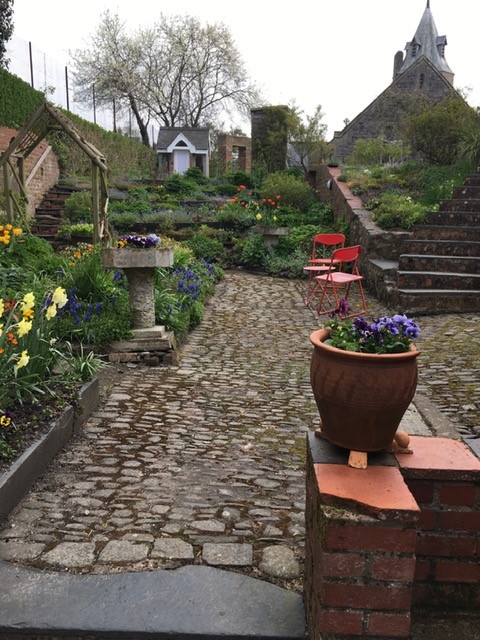 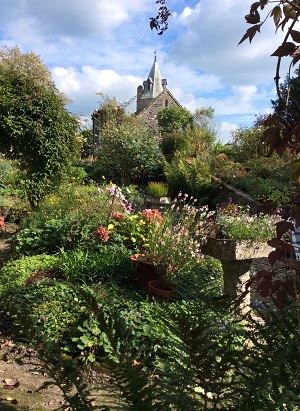 Anna's garden Irene's garden 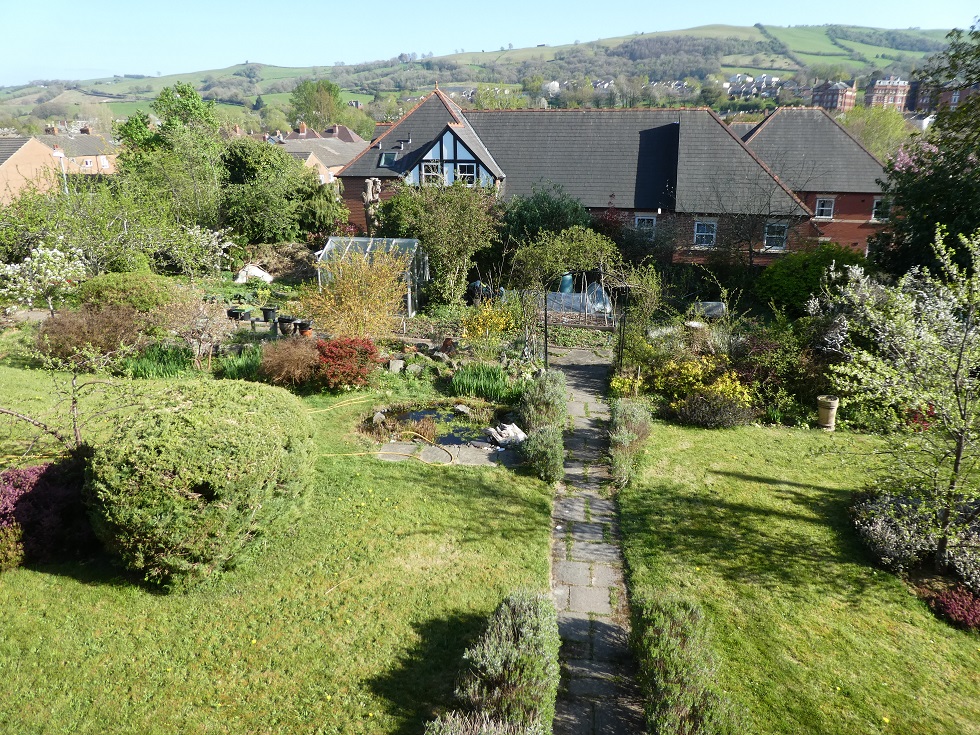 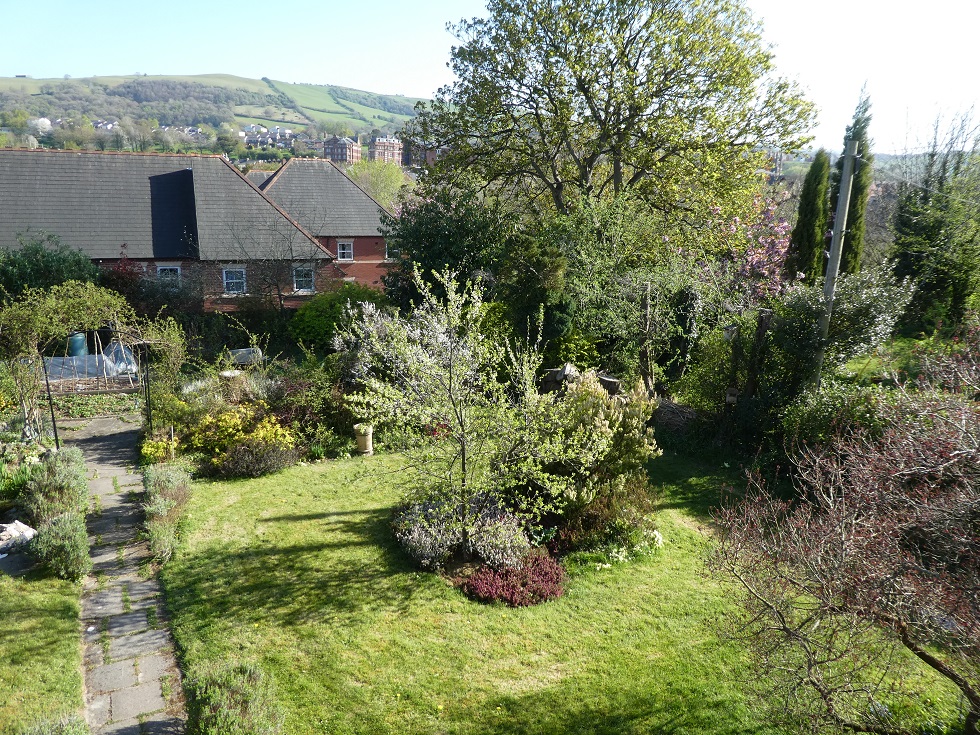 Mike's garden 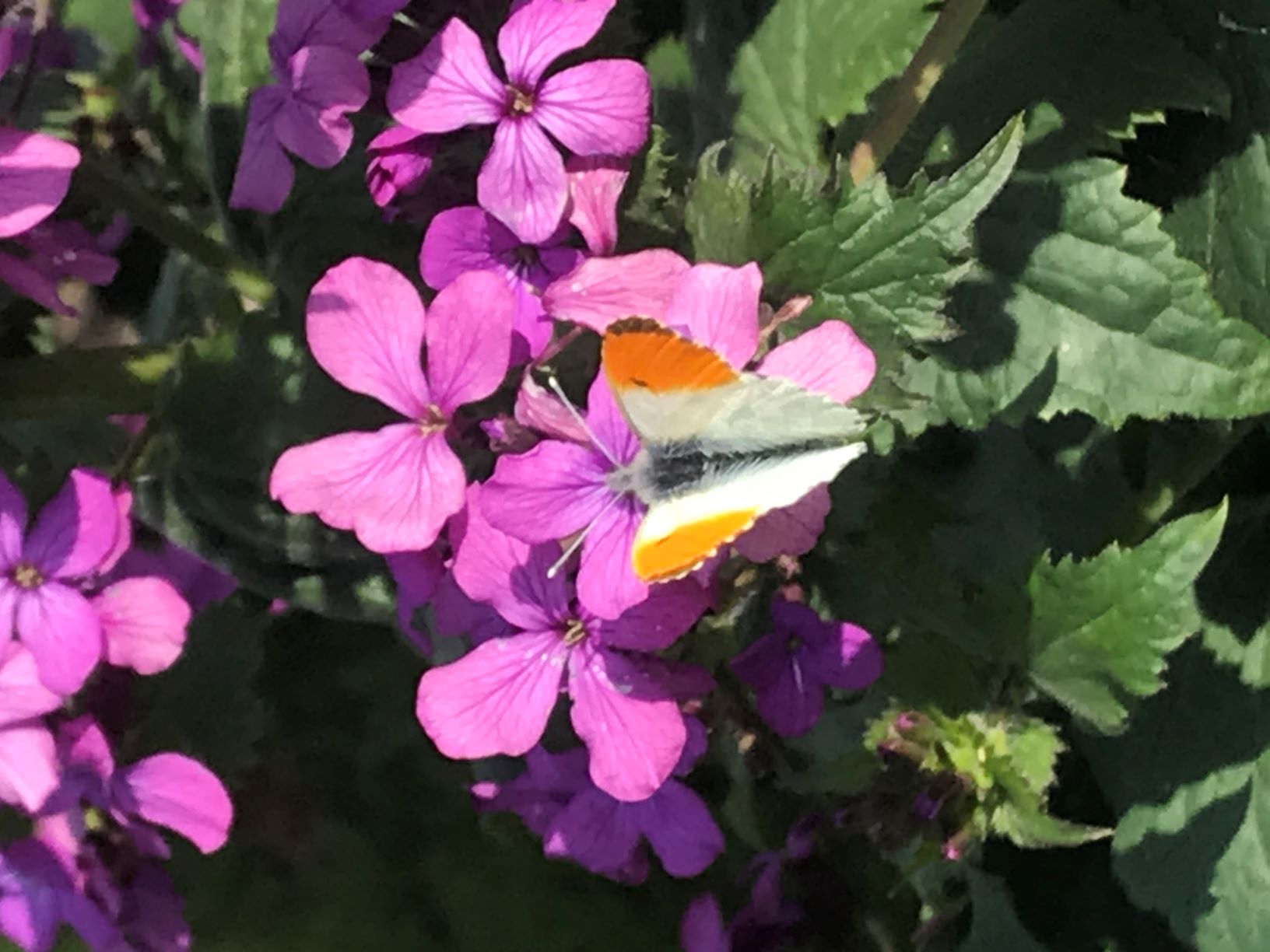 Paul's garden Cherry blossom Orange tip butterfly 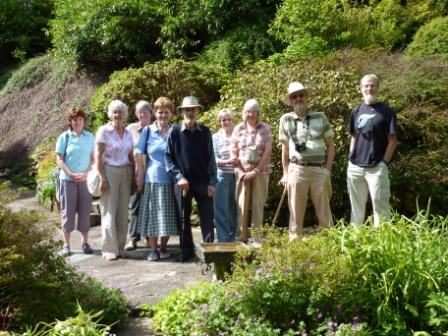 This is one of our group visits in the good old days, before social distancing. We look forward to group visits again. ____________________________________________________________________________________________________ The March meeting was at Anne's house, Tregynon, and started with a slide show of photos of plants in Annes's garden, most of them taken in summer/autumn . We then did our usual tasks for the month and had some lively discussion about when to sow seeds. A few items for the diary: 1st and 2nd May the Newtown Garden Club will hold a plant sale at the Newtown Market Hall. On Sunday 19th April the Shropshire Group of the Hardy Plant
Society will hold a Spring Fair at the Baystock Hill Memorial Hall ,
SY3 0DR. The December meeting was the non-Christmas get together at
Judi's
house. Judi talked about Charles Dowding and his approach to Organic
Gardening. He has adopted a no dig approach and uses cardboard
and compost to suppress weeds and maintain soil condition and
fertility. He also uses double cropping by the use of fleece and
polytunnels. With this approach and about half an acre of land he
achieves £20000 worth of veg sales a year. More details can be
found on his web site at https://charlesdowding.co.uk/ 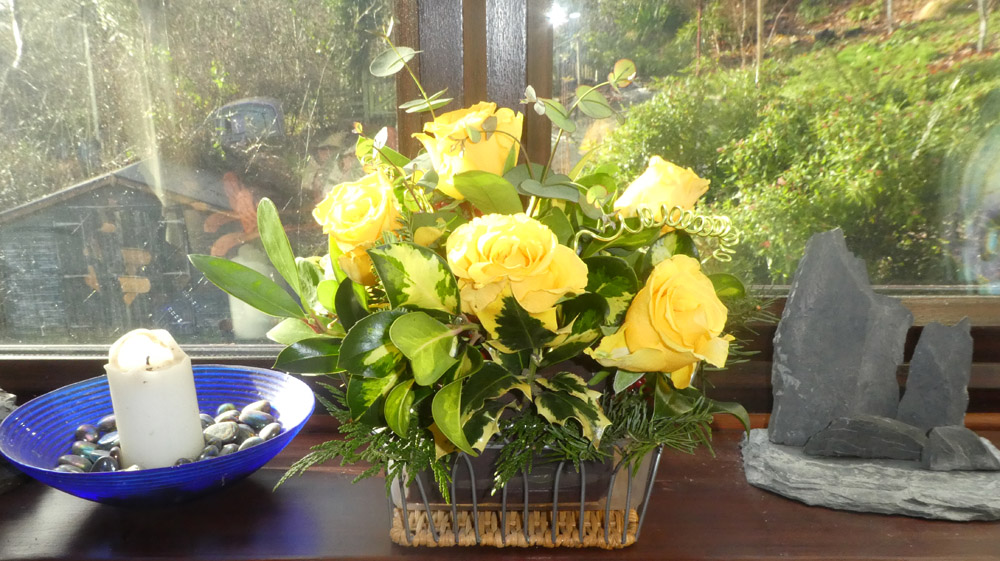 The November meeting at Jackie's consisted of a demonstration by Sheena of methods of propagation. Sheena brought samples of various shrubs and plants and demonstrated the correct way of taking cuttings, root, stem, leaf, hardwood, depending on the type of plant. We all took cuttings away to try for ourselves at home. Sheena also brought a selection of the many books she has on gardening and plants. Jackie provided refreshments as usual. Notes on Propagation by Sheena: 1. Herbaceous
perennials Prepare cuttings 2-3cm
in length inserting them right side up, with tip level with surface of
the
compost, in gritty compost or vermiculite ,1- 2cm or so apart. Label
and put in
a frame or sheltered spot. Water in then leave over Winter, watering
sparingly,
but making sure they do not dry out if under glass. When shoots appear
and are
growing strongly, feed, then pot up only when well grown. Plant out the
following spring. Semi- mature cuttings can be taken from perennials that remain green above ground in Winter eg: Achillea, Artemisia, Dianthus, Geranium, Hyssop, Iberis, Linum, Veronica Take cuttings 5-10cm long from the base of the plants in September. Insert in a suitable gritty compost. Place under glass. Pot up when growing strongly in spring. Basal cuttings, ideally with a bit of root attached, can be carefully removed from the plant stool in spring and potted up individually or in groups in gritty compost. 2. Deciduous
shrubs Some trees can also be propagated in this way: eg Acer, Eucryphia, Prunus, Salix. Evergreen
hardwood shrub cuttings Take cuttings either in late Autumn or early Spring. Select strong shoots. Trim just below a node. Several cuttings can be taken from a single shoot. Trim any large leaves by half to reduce loss of moisture. Insert in gritty compost and treat in the same way as deciduous cuttings. Spring cuttings will respond very well with bottom heat and will form strong plants very quickly. Pot on as soon as they are growing strongly and plant out in autumn or the following Spring. Conifers LayeringCan be successful with many shrubs and trees eg: Chaenomeles, Cotinus, Daphne, Dianthus, Euonymus, Lonicera, Rhododendron, Wisteria. Take a low supple branch in Autumn, Winter or early spring. Strip a section of bark about 1cm long or using a sharp instrument make a cut through 1/3 through the stem. Pin the stem into the ground with a wire peg, adding in a mixture of peat and grit around the wound. Mark with a stick. Leave for at least a year, sometimes two then sever the layer from the parent plant and then after a further 4-6 weeks lift carefully and replant in final place. The meeting in September was at Jackie's and was taken up by a
very
interesting talk by Sheena on propagating. Sheena had brought
samples of a number of different shrubs and showed us how to take
cuttings of the various types of plants and what to do with them to
ensure succeful propagation. These included shoot, root, leaf and
hardwood cuttings. Most of the members took away samples to try
in their own gardens. Sheena also brought a selection of her
extensive collection of gardening books. In August we went to Judi's and spent most of the meeting digging through her collection of HPS seeds due to be dumped if not wanted. Most of the members present found a number of promising prospects to try. Judi explained how the HPS seed collection and distribution works. After tea and cakes we explored Judi's garden which she admits is a work in progress but certainly looks very different from when she first moved into the property. We also discussed future meetings and activities, see side panel for details. In July we went to Bont Dolgadfan to visit Sheena's 'new'
house and
garden. First we visited another garden, the Old Vicarage,
in the village, arranged by Sheena, and this was a lovely, established
garden that the owners have been working on for fourty years. And
it shows, there is lots of variety, mature trees, ponds, terracing and
even productive fruit and veg production. Everything has been
done to encourage wildlife. We spent a couple of hours there
being shown around by the owners. 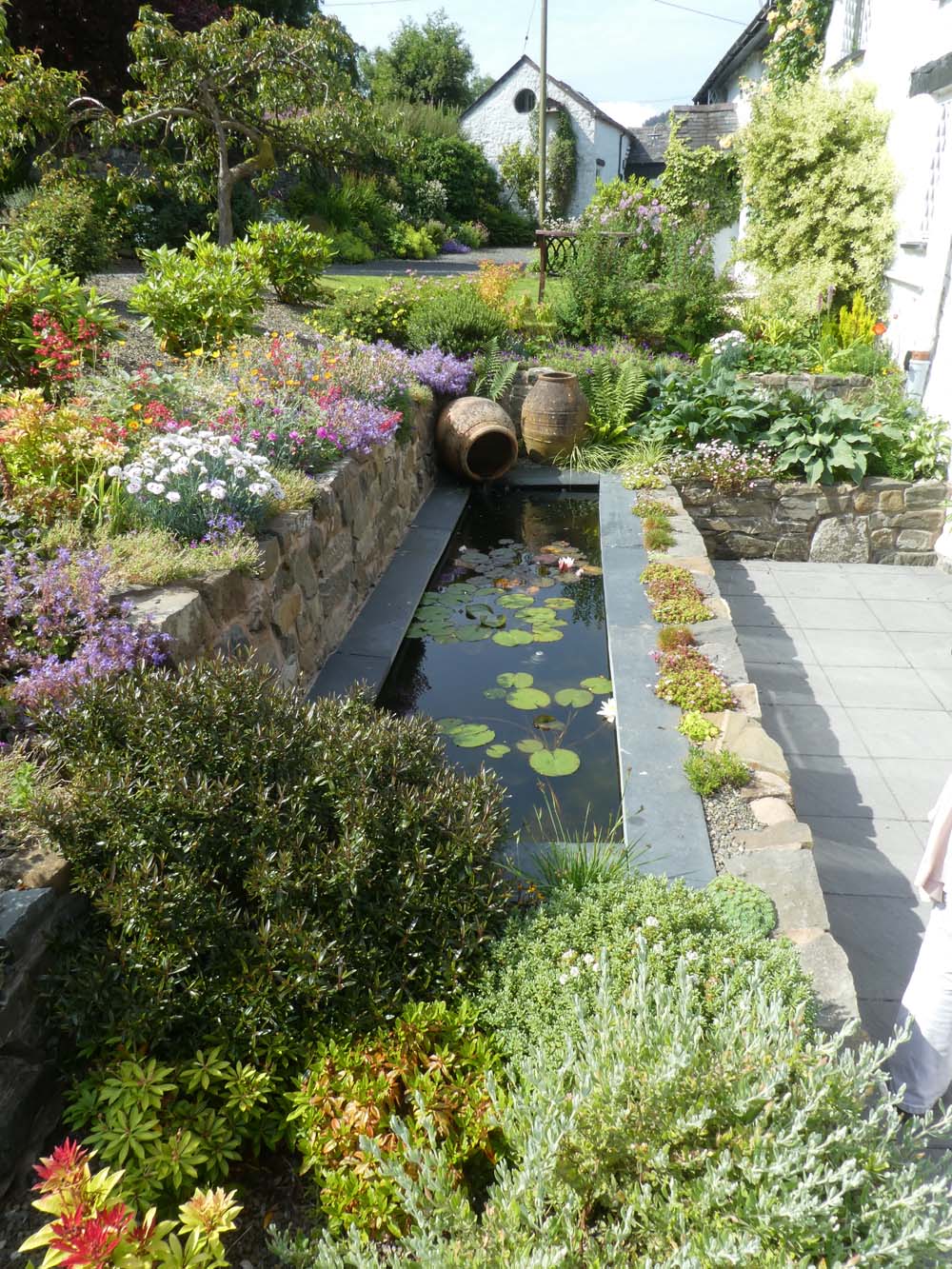 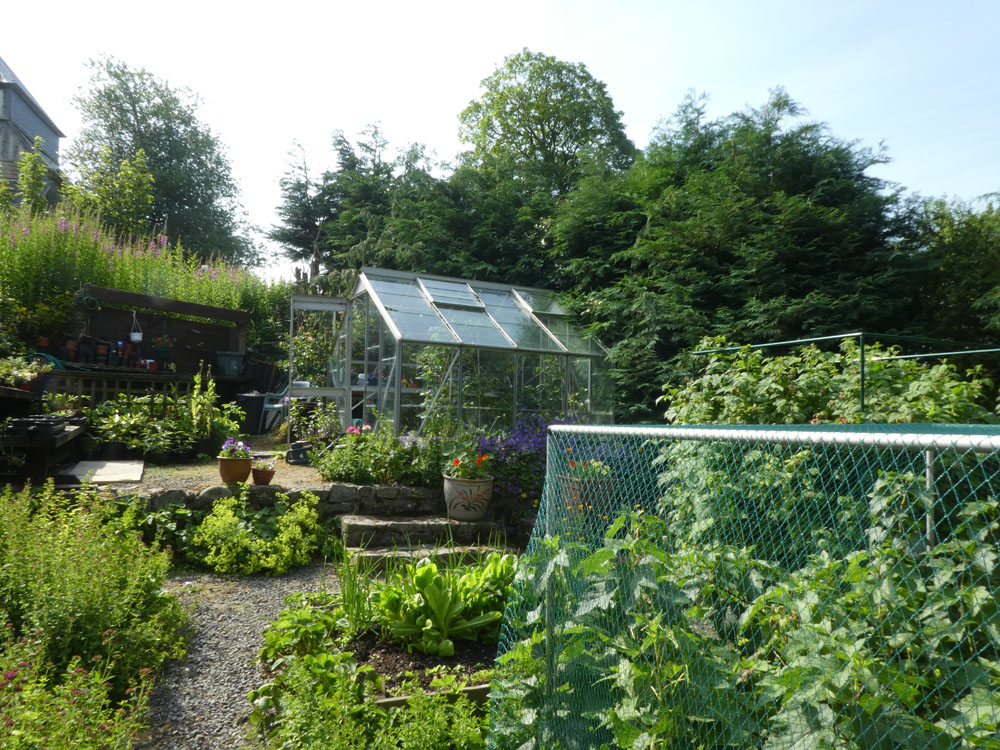 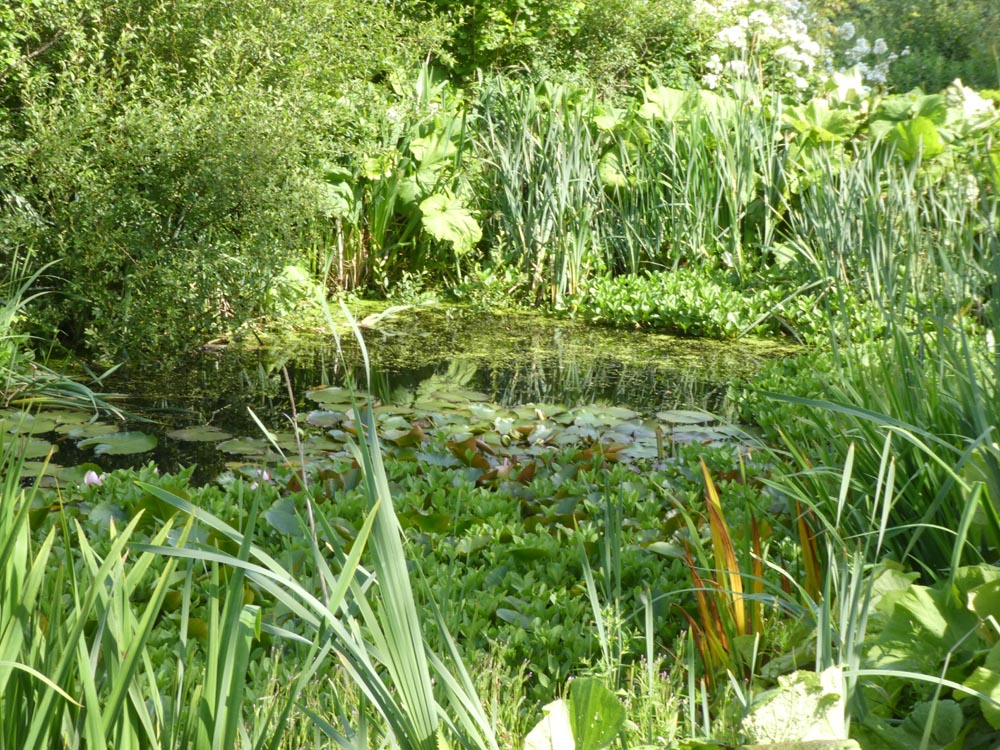 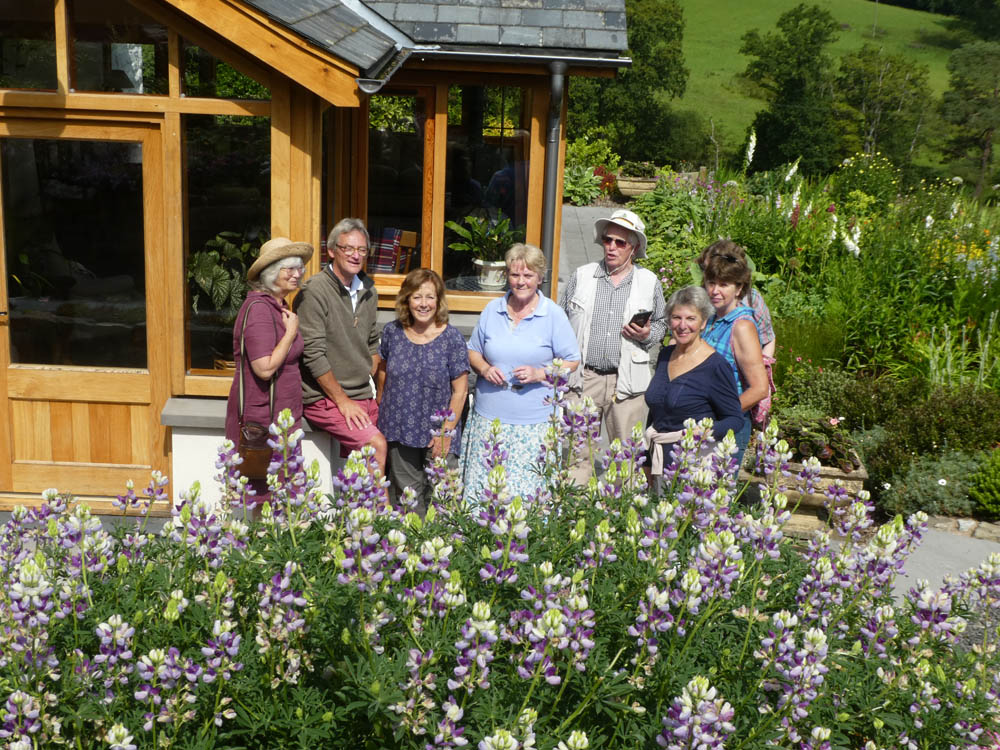 The June meeting was a combined one with the Walking Group to Hurdley Hall gardens then Roundton Hill for the walkers. This is our third visit to Hurdley and each time we are impressed by the gardens and the changes that take place. We particularly love the borders, the orchards, ponds, magnificent wildflower meadow and the veg plot. As on previous occasions we were also impressed by the quality of the home made cakes and scones. 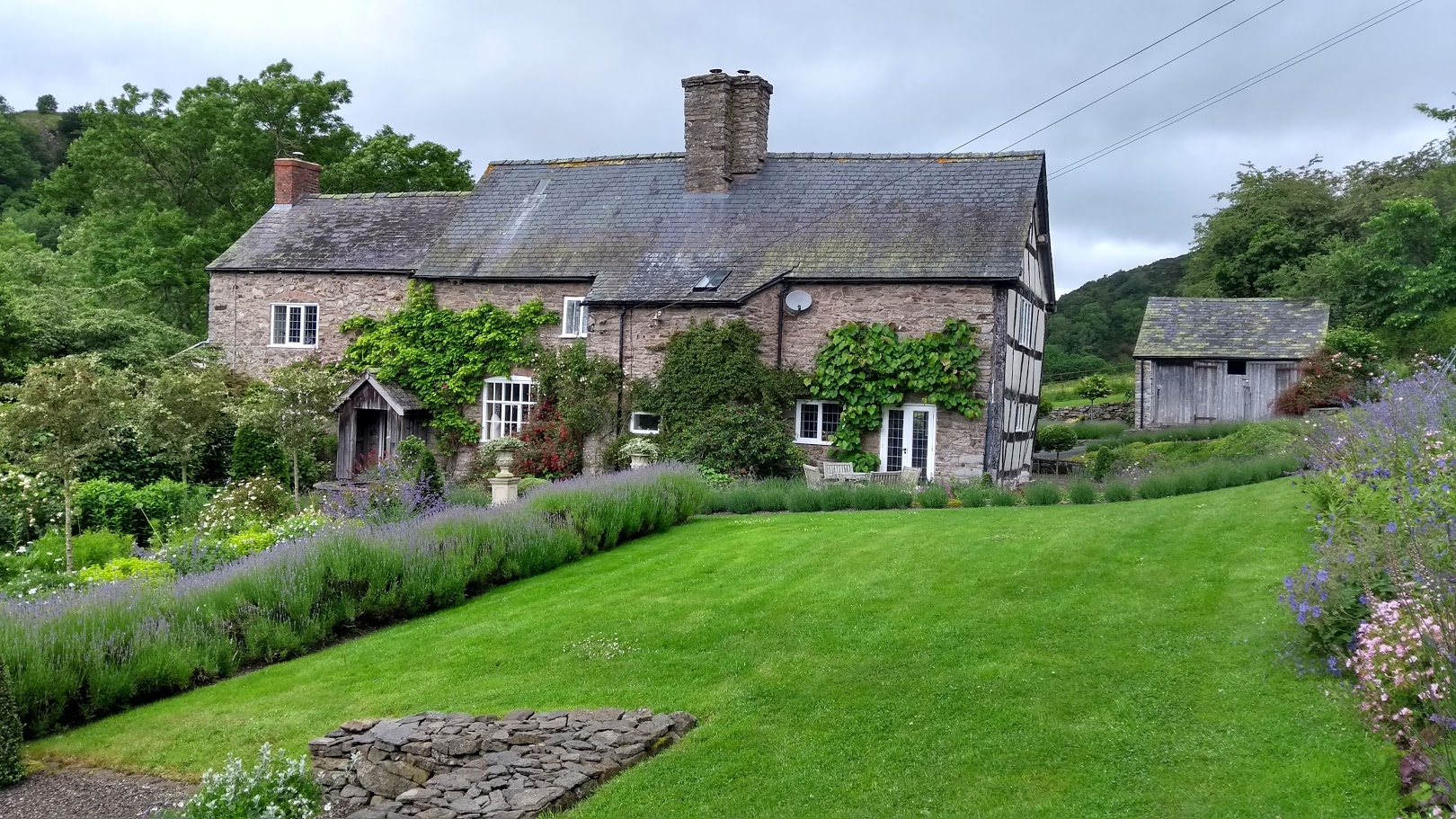   The May meeting was a visit to two very different gardens near Shrewsbury. The first was to Avocet which is a small garden divided into many different areas of interest. The whole garden is planned to encourage wildlife of all sorts with bee, bird and insect homes scattered throut. A very interesting and pleasant place to visit. We went from there to Bowbrook Allotments which is a large community allotment with all the plots well kept and productive. The areas around the site feature different aspects such as wild meadows, willows to aid solve water problems and a pond. Another very interesting place to visit, not surprisingly there is a waiting list for plots. Thanks to the owners of both properties and to Judi for organising the day. Events. 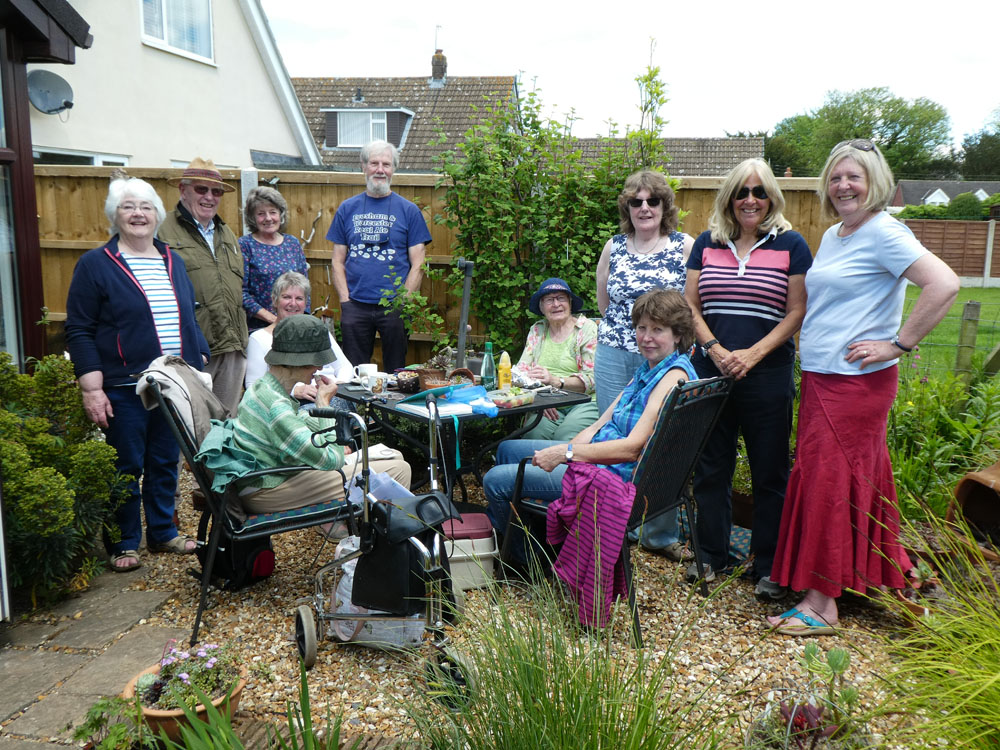 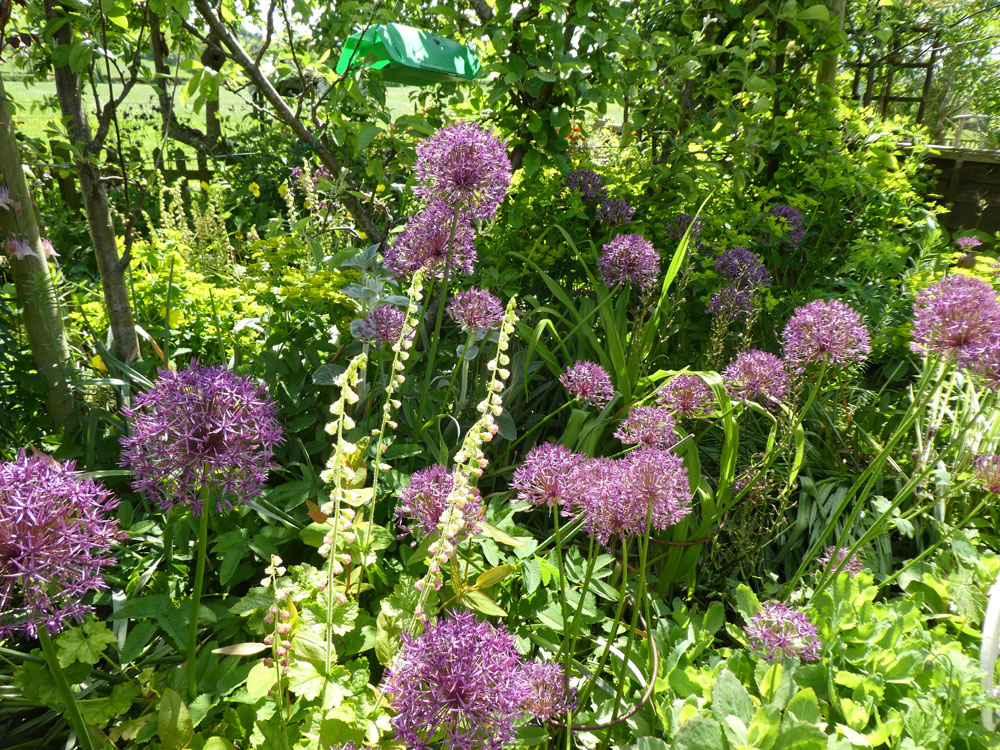 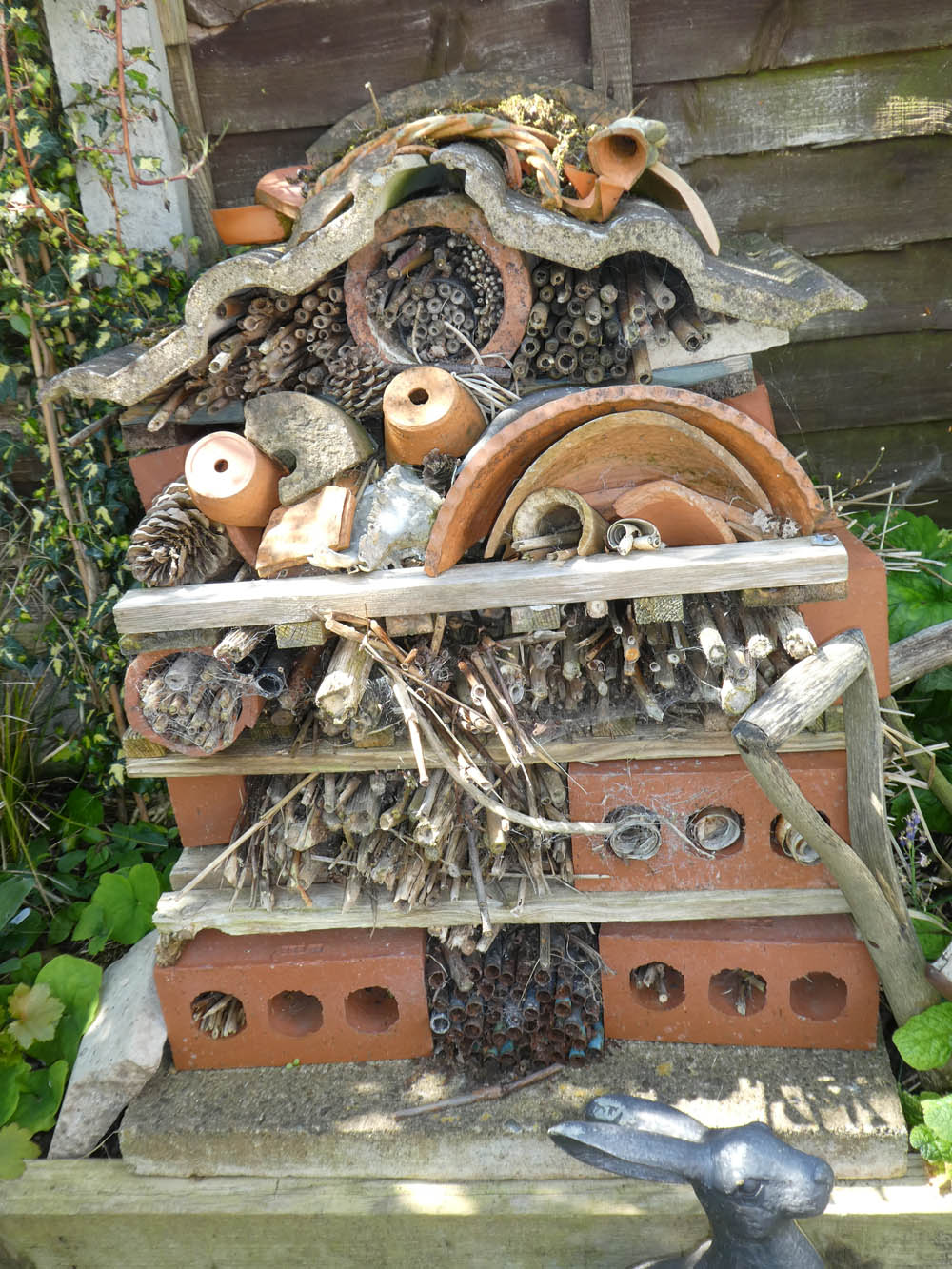 The meeting in May at Anne's started with a slide show of various gardens, including her own, Powis Castle, Portmeirion and others. We talked about things to do in the garden this month, a busy month of seed sowing and preparation. Judi told us about the Shropshire Hardy Plant Society's Spring Plant Fair, to be held at the Bayston Hill Memorial Hall, Sunday 14th April, 12.00-15.00. Non members welcome. The meeting in March was at Mike's and was well attended. Mike showed pictures from a recent trip to Madeira which is a very lush island with a number of excellent formal gardens. We also had a short quiz which proved to be too easy for these experienced gardeners. Then, after a short review of activities in the garden for this month, we discussed possible garden visits for the summer. The February meeting at Nick's mainly concentrated on plans for planting over the next couple of months. We also taked about possible visits including Broadheath House, Presteigne and the Dower House, Shropshire. The group also had a tour around the garden with very little happening at this time of year but we discussed possible pruning needed to shrubs and fruit trees. |
Meetings normally held:
|
| Links: Welshpool U3A The Virtual U3A (vU3a) | |
 Newtown Gardening Group
Newtown Gardening Group